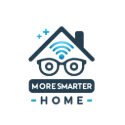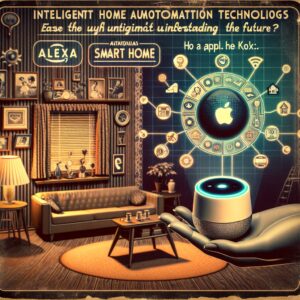Integrating Outdoor Security Cameras with Solar Power in Smart Homes
Discover how the eufyCam 3 4-Cam Kit, with its state-of-the-art outdoor wireless security cameras, can seamlessly integrate into your smart home setup, offering added convenience and security.
Setting up the eufyCam 3 was effortless with the user-friendly app and clear instructions. The night vision and intruder alert feature offered peace of mind for my property’s security. The solar panel charging ensured continuous operation, while customizable activity zones and voice control added convenience. Explore integrating outdoor security cameras into your smart home for enhanced convenience and security.
Seamless Integration of Smart Cameras into Your Smart Home Network

Experience unparalleled night vision capabilities with the eufy 4k camera’s Starlight system, delivering 4K quality and vivid colors in low-light environments, surpassing conventional 1080p cameras. The exceptional clarity and color accuracy ensure that every detail is captured, even during the darkest nights, providing reliable surveillance 24/7 without compromising on image quality. Discover how integrating this advanced technology into your smart home setup enhances both convenience and security, offering a seamless and intelligent solution for your surveillance needs.
Seamless Integration: Enhancing Your Smart Home with eufy Security eufyCam S330 (eufyCam 3)

Embark on a journey of seamless integration as you unbox the eufy Security eufyCam S330 (eufyCam 3) 4-Cam Kit, blending outdoor security camera systems into your smart home setup for unparalleled convenience and security. From the cutting-edge 4K ultra HD cameras with solar panels to the intuitive U home base, each component promises a harmonious fusion of technology and protection. With included accessories like wall mounts and an Ethernet cable, eufy’s dedication to a comprehensive security solution shines through, ensuring effortless installation and maintenance. This meticulous unboxing experience paves the way for a smooth setup process, seamlessly integrating outdoor security cameras into your smart home ecosystem for enhanced peace of mind.
Integrating Solar-Powered Security Cameras into Your Smart Home Ecosystem

Embrace the seamless fusion of outdoor security camera systems with your smart home setup for heightened convenience and protection. The eufy Security eufyCam S330 (eufyCam 3) exemplifies sustainable security through its solar-powered design, requiring minimal sunlight for continuous operation. This innovative integration not only ensures uninterrupted surveillance but also reduces the environmental impact, making it an ideal choice for eco-conscious homeowners. Experience the future of smart home security with the eufyCam 3, where performance meets sustainability in a harmonious blend.
Enhancing Outdoor Security: Smart Integration with Voice Control

The eufy Security eufyCam S330 (eufyCam 3) takes outdoor security to the next level by seamlessly integrating with voice control through Alexa or Google Assistant. This advanced feature not only enhances convenience but also elevates the overall smart home experience. By allowing users to effortlessly manage their security cameras with simple voice commands, eufyCam 3 becomes an integral part of a connected and intuitive home environment. This integration showcases a deep understanding of user needs, offering a customized and accessible security setup where activity zones can be set and system status toggled with ease. Positioned as a key player in the realm of smart home technology, eufyCam 3 provides a future-oriented solution that is efficient, reliable, and perfectly aligned with the theme of Smart Home Integration with Outdoor Security Camera Systems.
Enhancing Smart Homes with Secure Local Storage

Discover how the eufyCam 3 elevates your smart home with military-grade encryption and expandable local storage, seamlessly integrating into your smart home ecosystem for enhanced security and convenience. By prioritizing local storage over cloud-based solutions, eufyCam 3 provides a secure fortress for your surveillance footage, ensuring complete control and peace of mind. With its flexible storage options and user-centric approach, eufyCam 3 offers a scalable solution for properties of all sizes, embodying innovation and security in a smart home environment.
Enhancing Smart Home Security Through AI-Enabled Outdoor Camera Systems

The eufy Security eufyCam S330 (eufyCam 3) goes beyond traditional security measures by leveraging BionicMind AI to revolutionize surveillance. By distinguishing between familiar faces and strangers, this system offers tailored security that adapts to each household’s needs. With AI integration, the eufyCam 3 represents the future of home security technology, providing a smarter, more reliable, and nuanced security solution that truly understands and protects your home.
Pros:
- The eufyCam 3 offers crystal-clear night surveillance with its 4K Starlight system, ensuring vibrant colors and superior visibility in low-light conditions.
- Equipped with an integrated solar panel, the camera requires just two hours of sunlight for continuous operation, reducing the need for frequent recharges.
- Offers intelligent intruder alert through BionicMind AI, accurately identifying friends from strangers, enhancing security without additional charges.
Cons:
- Facial recognition functions optimally at around 10 feet, potentially making the camera more accessible to tampering due to the recommended installation height.
- Lacks integration with Smartthings, limiting compatibility within broader smart home ecosystems.
- The Base Station offers limited functionality and options for storage and recorded content management, which can be restrictive for users seeking comprehensive video editing solutions.
Conclusion
Discover how the eufyCam 3 4-Cam Kit seamlessly integrates into your smart home setup, providing unmatched convenience and security. Its eco-friendly design, privacy-first storage solution, and advanced features make it a valuable addition to any home. Embrace top-of-the-line security without monthly fees with the eufyCam 3.
Questions & Answers:
Question: How effective is the solar charging feature in less sunny areas?
Answer: The solar charging feature is impressively efficient, with users reporting full charges with just ambient sunlight. Even in areas with shorter daylight hours, the cameras maintain a good charge, quickly returning to 100% charge before nightfall.
Question: Can the eufyCam 3 integrate with voice-controlled home assistants?
Answer: Yes, the eufyCam 3 supports voice control through Alexa or Google Assistant, allowing for easy integration into your smart home setup for an enhanced experience.
Question: What are the main benefits of the local storage solution offered by eufyCam 3?
Answer: The eufyCam 3’s local storage solution provides military-grade encryption for safe data storage, expandable up to 16 TB, ensuring your privacy is protected without the need for subscription-based cloud services.
Integrating Outdoor Security Cameras with Solar Power in Smart Homes Read More »





